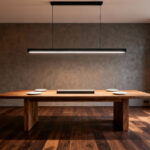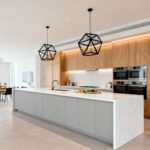Of all the design styles I work with, Bohemian is the one that gets people the most excited. It feels free, personal, and deeply comfortable—a space that’s been collected over time, not decorated overnight. And here’s what I’ve learned over a decade of designing homes: that philosophy of comfort and personality is the exact same foundation for truly great universal design.
A living room has to be more than just pretty. It needs to work for your toddler, your visiting grandma who uses a walker, and you after a long day. It’s about creating a space where everyone feels not just welcome, but truly at ease. So, forget the idea that accessible design is sterile or restrictive. Let’s look at how to blend that free-spirited boho charm with smart, practical solutions to create a living room that’s gorgeous for every body.
1. Layering Rugs for Depth and Texture
Okay, let’s tackle the first question I always get: “But won’t layered rugs be a tripping hazard?” It’s a fair point. But done right, layering is one of the best ways to get that rich, collected-over-time boho feel. It’s about breaking free from the single, perfectly-centered-rug rule.

Here’s the trick: Start with a large, low-pile foundation rug. Think jute, sisal, or a tight-woven wool—anything under a half-inch thick that won’t bunch up under a cane or wheelchair. This anchors the room. Then, you can layer smaller, more interesting pieces on top, like a vintage kilim or even a washable cotton rug. This adds the pattern and personality without creating dangerous, upturned edges. This way, you get all the visual interest and cushion underfoot, while keeping a safe, smooth path for everyone.
This combination of textures is what makes a space feel inviting. A rough, natural fiber paired with something soft and patterned tells a story—and it’s a story everyone in your home can be a part of.
2. Piles of Patterned and Textured Pillows
Nothing signals comfort quite like a generous pile of pillows. They’re the easiest way to splash pattern and texture around, turning a simple sofa into an irresistible place to land. For that classic boho vibe, don’t be shy. Mix global patterns—think Moroccan tiles or Indian block prints—with solids in interesting materials like chunky knits, velvet, or macramé.

From a universal design standpoint, pillows are secretly a fantastic tool. Offer a variety of firmness levels. My father-in-law needs a really firm cushion for his back, while my niece just wants to sink into a squishy pile on the floor. Including a few larger, sturdy floor pillows is a game-changer. They can be extra seating for kids, or a footrest for someone who needs to elevate their legs. They bridge the gap between floor-lounging and traditional seating.
It’s that mix-and-match approach that makes it work. Run your hand over a nubby linen pillow, then a cool, smooth velvet one. That sensory richness is what makes a space feel truly luxurious and comforting for all.
3. Cozy Throws Draped for Effortless Style
Throws are the ultimate accessory in a boho living room. They add warmth, color, and that perfect touch of “I just casually tossed this here” style. The key is to avoid folding them perfectly. Just let a chunky knit or a tasseled cotton throw fall naturally over the arm of a chair or the back of a sofa.

In a multigenerational home, throws are non-negotiable. They’re practical. Keep a few lightweight cotton ones for warmer days and some heavier wool blankets for when it gets chilly. What’s important is where you put them. Make sure they’re within easy reach of every main seating area, so someone with limited mobility doesn’t have to ask for help to get comfortable.
Draping throws is also a great way to experiment with color. Earthy terracottas, deep forest greens, and sandy neutrals create a calm, grounded feeling, which is the perfect backdrop for this relaxed style.
4. Bringing the Outdoors In with Abundant Greenery
Plants are not just decoration; they’re life. They breathe freshness into a room, soften hard lines, and connect us to nature, which is a core part of the bohemian spirit. And the good news is you don’t need a green thumb to make this work. Honestly, I’ve seen some of the most beautiful plant-filled homes owned by self-proclaimed “plant killers.”

If you’re worried, here are a few of my go-to, nearly indestructible options for an accessible space:
- Snake Plants: Upright and dramatic, they forgive almost any mistake.
- Pothos: These trailing vines are happy in low light and tell you when they need water by drooping a little.
- ZZ Plants: So tough they’re sometimes mistaken for plastic. Glossy, beautiful, and independent.
- Spider Plants: They clean the air and produce little baby plants you can share. What’s not to love?
When placing them, think about different heights. A large plant on the floor, another on a stand, and maybe one hanging can create a lush, jungle-like feel without cluttering up the walkways that need to stay clear.
5. Low-Level Seating for a Relaxed, Grounded Feel
Low-profile sofas, floor cushions, and poufs are what create that signature, informal boho vibe. They encourage a different kind of lounging—more casual, more connected. It breaks down the formality of traditional furniture arrangements and just feels more inviting.

But—and this is a big but—low seating doesn’t work for everyone. I’ve seen clients go all-in on floor cushions, only to realize their parents can’t visit comfortably anymore. The best approach from a universal design perspective is to offer a variety of seating heights. Create zones. Have that low-slung sofa and pile of floor cushions for those who love it, but make sure you also have a chair or sofa section with a seat height around 18-20 inches and sturdy arms for support. That makes it easier for someone with knee or hip issues to get up and down gracefully.
Good design is about giving people choices, not forcing them into a single way of living. A truly boho space embraces everyone.
6. Adding Poufs and Floor Cushions for Extra Comfort
Poufs and floor cushions are the flexible workhorses of a bohemian living room. They’re movable, versatile, and instantly signal that this is a room for relaxing, not just for looking at. You can pull them over for an impromptu board game on the floor or use them as a footrest.

In the homes I design for multigenerational families, these pieces are invaluable. A sturdy leather pouf can be the perfect perch for a child, a footrest for an older adult needing to improve circulation, or an intermediate seat for someone who can’t sit all the way on the floor but finds the sofa too high. Look for ones with handles—it makes it so much easier for anyone to move them around.
When clients ask how to keep it stylish, I suggest mixing materials and firmness levels. A woven jute pouf next to a soft velvet floor cushion adds layers of texture and ensures there’s an option for every preference.
7. Hanging Tapestries and Textile Wall Art
Want to add instant warmth and character? Hang a tapestry. Unlike a glass-framed print, textiles on the wall absorb sound, which immediately makes a room feel cozier and more intimate. This is huge for people with hearing sensitivities or for just making conversation easier to follow. Tapestries with global motifs bring a sense of history and wanderlust right into your living room.

From an accessibility standpoint, textile art has a few hidden benefits. It adds color and pattern at different eye levels, so the room is just as interesting for someone seated in a wheelchair as it is for someone standing. I once worked with a family where we used a long, beautiful textile to visually define the path from the living room to the dining area—a soft, beautiful cue that helped their grandfather with cognitive impairment navigate the space.
This is also a fantastic solution for renters who can’t paint. A single, large textile can completely change the feel of a room without any permanent changes.
8. Intricate Macramé and Woven Wall Hangings
There’s something special about macramé and other woven hangings. They feel handcrafted, personal, and connected to the natural world. Their soft, organic shapes are the perfect antidote to the hard lines of furniture and walls, contributing to that relaxed, layered boho vibe.

One of the first things you learn in accessible design is that texture is a superpower. For someone with low vision, a highly textural wall hanging provides a different kind of sensory interest that a flat painting can’t. It adds depth and character without creating visual clutter on the floor.
And here’s something I love: many of these pieces are made by artisan collectives that support makers with diverse abilities. When you source your decor thoughtfully, the story behind the piece becomes part of the beauty of your home.
9. Ambient Lighting with String Lights and Lanterns
Harsh, overhead lighting is the enemy of a cozy, relaxed atmosphere. The magic of a boho living room often comes alive at night, and that’s all thanks to soft, layered lighting. Think string lights, paper lanterns, and maybe a salt lamp or two. This kind of diffused, warm glow creates an intimate mood perfect for conversation or quiet evenings.

This isn’t just about aesthetics; it’s a critical aging-in-place strategy. As we get older, our eyes need more light to see, but they also become more sensitive to glare. A layered lighting plan is the solution. Use those beautiful string lights for overall ambient glow, but make sure you also have good task lighting—like a floor lamp with an adjustable head—next to a favorite reading chair.
I often suggest putting string lights or lamps on smart plugs or dimmers. It gives everyone, regardless of mobility, the power to adjust the light to their own comfort level with a simple voice command or app.
10. Incorporating Rattan and Natural Wood Elements
Rattan, wicker, and natural wood are essential for grounding a boho space. These materials bring the warmth and texture of the outdoors in, making a room feel authentic and connected to nature. Whether it’s a rattan accent chair, a light-wash wooden coffee table, or a shelf made from reclaimed wood, these pieces add a story.

When you’re choosing furniture, especially for a home with young children or older adults, keep an eye out for rounded edges. They are much more forgiving than sharp corners if someone takes a tumble. And while a vintage rattan chair might look amazing, give it a sit-test. Does it feel sturdy? Is the seat height comfortable (again, 18-20 inches is a good benchmark)? Some stylish pieces simply don’t offer the support needed for long-term comfort.
The beauty of these materials is that they show their age gracefully. A little patina or a few scuffs just add to the character, reinforcing that lived-in, imperfection-is-welcome philosophy.
11. Fearlessly Mixing Bold Patterns and Prints
This is where the fun really begins. The soul of bohemian style is in its fearless, joyful mixing of patterns. It’s how you make a space uniquely yours. The key isn’t chaos; it’s finding a thread to tie it all together. Maybe it’s a shared color palette or a similar scale of print. Start with one big statement—a patterned rug or sofa—and then layer in smaller patterns with your pillows, throws, and art.

Now, for some people, especially those with sensory processing differences, too much pattern can be overwhelming. The secret isn’t to avoid pattern, but to create “visual rest stops.” Break up patterned pillows with solid-colored ones. Leave a bit of a neutral wall exposed between two bold tapestries. This balance keeps the eclectic energy of boho while making the space feel calm and navigable for everyone.
Think of it like a good conversation. You need pauses and moments of quiet to appreciate the exciting parts.
12. Embracing a Rich Palette of Earthy and Jewel Tones
The boho color story is one of my favorites because it’s so rich and balanced. You start with a foundation of earthy tones—terracotta, olive green, sandy beige, warm brown. These colors feel grounding and calm. Then, you punch it up with vibrant jewel tones like sapphire blue, emerald green, or ruby red. It’s a combination that feels both energizing and serene.

From a design-for-all perspective, this color strategy is brilliant for creating contrast. Good contrast is vital for people with low vision to navigate a space safely. That deep emerald green pillow really pops against a cream-colored sofa, making it easier to see. A dark wood table stands out against a light-colored rug. It’s a simple principle that makes a huge difference in how usable a space is.
You don’t have to paint a whole wall in a jewel tone. A single velvet armchair, a cluster of colorful vases, or a bold piece of art can provide that jolt of energy.
13. Displaying Global Artifacts and Travel Souvenirs
A home’s personality comes from the stories it holds. Bohemian style encourages you to put those stories on display. That mask you bought on a trip, the woven basket from a local market, the pottery your aunt made—these are the things that make a space feel authentic and loved. Unlike mass-produced decor, these pieces are conversation starters.

When you’re setting up these displays in an accessible home, think about a variety of sightlines. Place some items on lower shelves or coffee tables so they can be appreciated up close by a child or someone in a wheelchair. And don’t be afraid to create tactile displays. Objects that are safe to touch—like a smooth carved stone or a textured textile—can be an incredibly rich experience for everyone, especially those who explore the world through touch.
Your home should be a reflection of your journey. Let your walls and shelves tell that story.
14. Using Unique and Decorative Mirrors
Mirrors are a designer’s secret weapon. In a boho living room, a mirror is more than just a place to check your reflection; it’s a piece of art. Look for frames with character—sunbursts made of rattan, intricate wood carvings, or colorful mosaic tiles. They add texture and become an instant focal point.

Practically speaking, mirrors are fantastic for universal design. A well-placed mirror can bounce natural light into a dark corner, making the whole room feel brighter and larger, which helps with visibility and navigation. Stay with me here, because placement is key. You want to avoid positioning a mirror where it could create a confusing reflection—for example, directly opposite a doorway, which might confuse someone with dementia. The goal is to enhance the space, not create disorientation.
Hang them at a height where both seated and standing individuals can enjoy them, and watch how they open up your room.
15. Curating Open Shelves with Art and Objects
Open shelving is pure boho. It’s an invitation to showcase your personality—your favorite books, a collection of plants, meaningful objects, and art. It creates a layered, lived-in look that feels much more personal than hiding everything away behind closed doors.

Styling these shelves for an accessible home requires a bit of strategy. This part’s important: place the things you actually use, like your favorite mugs or a stack of magazines, on the shelves that are easiest to reach (roughly between your waist and shoulder). Use the higher or lower shelves for things that are purely decorative. Make sure the shelves themselves are securely mounted and don’t stick out into main pathways where they could become an obstacle.
I love how open shelves encourage us to be mindful about what we own. When it’s all on display, you tend to curate a collection of things you truly love.
16. Hunting for Vintage and Secondhand Treasures
The soul of an authentic boho room is often found in the thrill of the hunt. Trawling through a vintage shop, flea market, or online marketplace for that one-of-a-kind piece is part of the process. A vintage credenza, a slightly-worn Persian rug, or a set of mismatched brass candlesticks bring a sense of history and character that you just can’t buy new. Plus, it’s a more sustainable way to furnish your home.

When you’re vintage hunting for an accessible space, you need to be a practical treasure hunter. Is that gorgeous old chair sturdy? Sit in it. Wiggle it. Is the seat a comfortable height, or would it be impossible for your dad to get out of? The beauty of vintage is that it often can be modified. I once helped a client add small, discreet risers to a stunning mid-century coffee table to make it a more comfortable height for her to use from her power chair.
Your home shouldn’t look like it was pulled from a single page in a catalog. It should look like it was built from a lifetime of interesting finds.
17. Creating a Cozy Reading Nook or Meditation Corner
Even in a bustling family living room, we all need a little corner to call our own. Creating an intentional space for quiet—whether for reading, meditating, or just drinking a cup of tea in peace—is a beautiful expression of the boho focus on well-being. It’s about carving out a small sanctuary to disconnect from the noise and reconnect with yourself.

A great universally designed nook is all about options. Include a comfy chair with good support as well as a few floor cushions. Make sure there’s an adjustable lamp to accommodate different eyesight needs. Keep a soft throw within arm’s reach. And a small, stable table is a must for setting down a book or a drink. You’re creating a little pocket of comfort that anyone can use.
So many homes have an awkward, unused corner. This is the perfect way to give that space a purpose and make your living room even more functional.
18. Maximizing Natural Light and Airy Vibes
Natural light is everything. It makes colors pop, plants thrive, and moods lift. A bright, airy room feels more spacious and energizing, which is central to that free-spirited boho feel. Even a room filled with layers of textiles and objects will feel open and uncluttered if it’s flooded with good light.

For anyone aging in place, maximizing natural light is a top priority for safety and well-being. As we age, our pupils get smaller and our lenses yellow, meaning we need significantly more light to see clearly. So, swap heavy drapes for sheer, gauzy curtains that let light filter through. Use mirrors to bounce light around the room. And try to keep window sills clear so you’re not blocking that precious resource.
I get it, privacy is a concern, especially on the ground floor. A great solution is top-down/bottom-up shades. You can lower them from the top to let in light while keeping the bottom half covered for privacy. Best of both worlds.
19. Adding Warmth with Candles and Incense
A home should engage all the senses. The soft flicker of a candle and the subtle scent of sandalwood or lavender can instantly make a space feel more immersive and comforting. The vessels themselves—ceramic holders, amber glass jars, or intricate metal burners—are beautiful decorative objects that add to the eclectic, global feel of a boho room.

But open flames can be a real worry in a home with kids, pets, or anyone with cognitive impairments. This is where modern technology is our best friend. High-quality flameless LED candles give you the same warm, flickering glow with zero fire risk. And for scent, an essential oil diffuser is a fantastic alternative to incense, allowing you to fill the room with natural fragrance without any smoke.
It’s about creating that multi-sensory experience safely, so everyone can relax and enjoy the atmosphere.
20. Making a Statement with a Large Area Rug
If you want to make an immediate impact, start with a statement rug. It’s the anchor of your living room, the piece that sets the tone for everything else. A bold Turkish kilim, a colorful Moroccan Boucherouite, or a deeply patterned Persian-style rug can be the perfect foundation for a boho space, tying all your eclectic furniture and decor together.

Here’s the crucial accessibility check: make sure it’s a low-pile rug (less than ½ inch thick) and secure it with a good quality non-slip pad. Edges must lie flat. If an edge absolutely refuses to cooperate, a bit of rug tape is your best friend. A flat, secure rug defines the space without becoming a hazard for shuffling feet, canes, or wheels.
A great rug does more than just look good. It visually defines a “zone,” like the main conversation area, which intuitively tells people how the space is meant to be used.
21. Hanging Plants or Decor from the Ceiling
Don’t forget to look up! The ceiling is often the most under-utilized surface in a room. Hanging plants or a lightweight textile from above adds vertical interest and a touch of the unexpected. Trailing plants like pothos or string-of-pearls create a lush, slightly wild feeling that is so perfectly boho.

When designing for safety and accessibility, anything you hang needs to be placed with care. You have to ensure there’s proper head clearance—at least 7 feet, and even higher over a spot where someone might stand up from a chair. The goal is to draw the eye upward and add dimension without creating an obstacle for a tall person or someone who may not be looking up as they move through the space.
Hanging elements above and outside of the main traffic paths is the perfect way to get that layered, three-dimensional effect without sacrificing clear, safe floor space.
22. Infusing Personality with Personal Art and Photos
A home should tell the story of the people who live there. Boho style champions this idea by encouraging you to display your personal photos, your kids’ artwork, and meaningful mementos. A gallery wall that mixes a framed photo from a family vacation, a small woven piece, and a child’s painting is infinitely more interesting and warm than generic store-bought art.

To make these displays inclusive, vary the heights. Hang some pieces lower on the wall where they can be seen from a seated position. A tactile frame or a small sculpture placed on a reachable shelf invites interaction. I love seeing families create displays that evolve over time, adding new photos and treasures as they create new memories.
It’s this personal layer that transforms a house into a home. It’s the composition of your life, right there on the wall.
23. Creating Accessible Pathways in Layered Spaces
This might be the most important point of all. There’s a common misconception that a layered, bohemian look means clutter. It doesn’t. A well-designed boho room has richness and depth, but it also has breathing room. You can absolutely have that lush, collected style while maintaining clear, safe pathways for everyone.

As a rule of thumb, aim for pathways that are at least 36 inches wide—and 42 inches is even better. This allows enough room for a person using a walker or wheelchair to move through the space with ease. You can achieve this by floating furniture away from the walls, using round coffee tables that are easier to navigate around, and using area rugs to visually define walkways. It’s about being intentional with your layers.
Good design is thoughtful. It anticipates needs. Building these clear paths isn’t a restriction on your style; it’s the detail that makes your beautiful, free-spirited room work beautifully for every single person you love.
Conclusion
In the end, creating a bohemian living room that’s also universally designed isn’t about following a strict set of rules. It’s about embracing a philosophy of comfort, personality, and welcome. It’s about layering textures that feel good, choosing colors that bring you joy, and telling your family’s story through the objects you collect.
By weaving in these principles of accessible design, you’re simply future-proofing your own comfort and ensuring your home is a true sanctuary for everyone, at every stage of life. The result will be a space that isn’t just stunning, but deeply and truly livable. A place where everyone can pull up a seat—or a floor cushion—and feel right at home.






